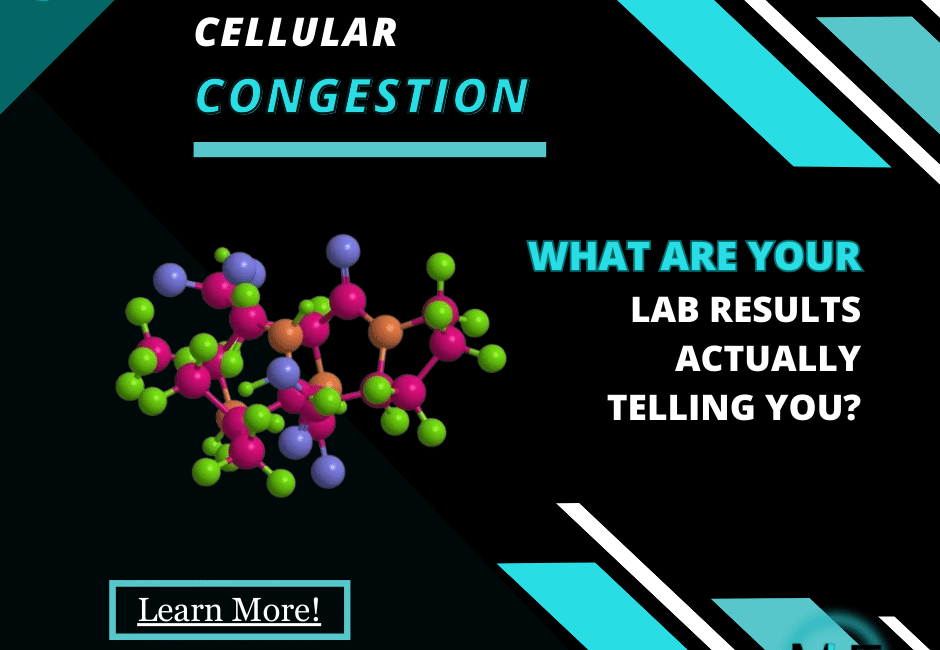Let’s say your bloodwork looks “normal.” You’ve been told everything checks out. But here’s the thing: you don’t feel normal.
You’re bloated. You’re foggy. You’re exhausted after meals. Your hormones are off. And your body seems to be shouting “I need help!” while your labs whisper “You’re fine.”
Sound familiar?
Here’s where we dig into something deeper that often doesn’t show up on a basic lab panel but can be identified through smarter analysis:
cellular congestion.
What Is Cellular Congestion?
Think of your cells like tiny kitchens. They’re supposed to cook up energy, metabolize nutrients, and take out the trash. But if the trash piles up (toxins, damaged proteins, waste products), and the fridge is empty (low nutrients), your cell can’t function optimally.
That’s cellular congestion.
It’s not a single disease — it’s a condition where your cells are under-functioning because they’re overloaded and undernourished.
How It Shows Up In Lab Work
Most conventional lab markers won’t say “you have cellular congestion” — but they give clues. Here’s what to look for:
🔻 Low-Normal T3 or Free T3
Tells us your thyroid wants to perform, but the cells can’t utilize the hormone efficiently. Why? The cell may be inflamed or oxidatively stressed.
🔺 Elevated TSH (with “normal” T4)
Suggests the brain is begging the thyroid to work harder — but the system is clogged.
🔻 Low Vitamin D
A sign of poor absorption or usage. Vitamin D is essential for mitochondrial health and inflammation control.
🔺 High Reverse T3
Your body is converting thyroid hormone into an unusable form, a clear sign of stress or congestion.
🔺 Elevated CRP, Homocysteine, or Ferritin
These inflammation markers may be slightly elevated, not flagged as dangerous, but they still tell us something is clogging up the system.
🔻 Suboptimal ALT/AST
Not high enough to flag as liver disease, but low enough to suggest poor detoxification. The liver’s ability to process toxins may be underpowered.
🔺 Triglycerides or Low HDL
Indicates impaired fat metabolism, sluggish bile flow, and mitochondrial sluggishness.
The Root Cause: It’s Not Just “Stress” or “Getting Older”
Cellular congestion isn’t just about stress or aging — it’s a metabolic traffic jam. Your body is stuck in survival mode.
- Sluggish bile flow? Can’t break down fats or detox.
- Oxidative stress? Your mitochondria (energy-makers) are burning out.
- Poor gut health? More toxins get absorbed than cleared.
- Low nutrient status? Cells can’t make energy or repair.
What You Can Do About It
- Start with a full lab review (not just a standard panel).
Look at thyroid panels, inflammation markers, liver enzymes, and nutrient levels through a functional lens. - Support bile flow and detox pathways.
Supplements like bile salts, bitters, taurine, or Eminent Bile Boost can be game changers. - Prioritize mitochondrial nutrients.
Think: magnesium, CoQ10, B-complex, NAC, and carnitine. - Lower toxic burden.
Swap seed oils, plastics, and chemical-heavy personal care products. Your cells will thank you. - Get light + movement.
Morning sunlight and gentle movement improve cellular signaling and mitochondrial efficiency.
The Big Picture
Cellular congestion isn’t just a biohacking buzzword. It’s a real, measurable block to your healing.
If you’re doing “everything right” but still feel stuck, sluggish, or off…
👉 your cells might be drowning in trash, starved for nutrients, or overwhelmed by toxins.
Let’s get eyes on your labs — through a lens that actually connects the dots between your symptoms and your cellular function.

